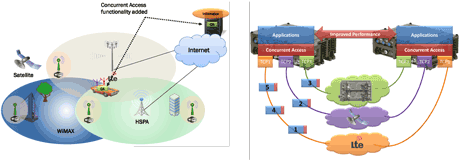by Gerard Hoekstra and Rob van der Mei
The spectacular growth of mobile internet on smartphones and tablet computers has boosted the demand for fast wireless networks. By 2015, mobile data exchange is expected to be 26 times larger than it was in 2010 [1]. In the first six months of 2012, the mobile internet traffic volume in the Netherlands was 21% higher than that recorded in the last six months of 2011 [2]. A highly promising means to meet the increasing demand is to take advantage of the fact that many geographical areas are covered by a multitude of overlapping networks. This phenomenon is referred to as concurrent access (CA). CWI and technology company Thales Nederland B.V. have developed new methods to make efficient use of the possibilities of CA by developing and implementing smart algorithms to split traffic over the multitude of wireless access networks.
Most locations in developed regions are covered by a multitude of overlapping wireless networks from several network providers that have 3G/4G networks deployed, as well as hotspots and local Wi-Fi-networks. Usually, users can only access one of these networks at a time. But what if several of the available networks could be used simultaneously? Would splitting data over two wireless networks also make mobile communication twice as fast? And would it increase the overall performance of the communication? The results of research by CWI and Thales exceeded expectations: simultaneous use of two networks did not just double the speed of wireless communication, but could increase it up to a factor of ten.
High speed gain
The key factor in this speed gain is the strong fluctuation in available network capacity. In this context, one may use temporal under-utilization in one network to compensate for congestion in the other network. Even if both networks are fully utilized, there are still very high fluctuations in supply and demand of network capacity on a micro scale. The main idea is to split traffic streams over the different access networks in such a way that the user-perceived performance is optimal, for example by assigning packets to the network with the lowest utilization. This smart assignment of packets to parallel wireless access networks not only leads to an increase in the network throughput, but also leads to great enhancements of response-time performance, availability and robustness of the applications.

Removing peaks in capacity demand is very effective in reducing congestion. As in several logistic problems, speed is not linearly, but rather exponentially, related to available capacity. If the number of cars on a road could be decreased by 10% during rush hour, traffic jams would not decrease in length by 10%, but would be halved or even eliminated. The same happens in wireless networks: the download times of individual users can be up to ten times shorter when capacity peaks are flattened by using two networks at the same time.
Sharing networks
The developed techniques can be realized in the short term, simply by devising a smartphone that can combine any mobile networks, hotspots or Wi-Fi-networks, and a piece of software based on our models. But for a more effective implementation, network providers need to adapt their software and hardware to this new mode of operation and more importantly, reach an agreement with competing providers to share networks.
Application areas
Many application areas, such as emergency and security services and the military, could greatly profit from fast and reliable networking. Such organizations could use their own networks to profit from these new techniques.
Developing the model
The mathematical challenge of modelling the use of multiple networks at the same time lies in devising accurate models that determine how the file should be split. The complication lies in the fact that the networks involved are coupled: the download starts at the same time in all networks, with transported data through each network depending on the original file size and the statistical (stochastic) variation in available capacity in each network.
We first developed an accurate, experimentally verified model of file downloads in a single network. This model is based on queuing; abstractions used in computer science to model waiting lines. The behaviour of multiple networks was modelled by a network consisting of several of these queuing abstractions. The performance of these networks and the efficiency of the splitting algorithms was analysed and optimized using Processor Sharing models and optimization techniques like Markov Decision Processes and Bayesian analysis. By assuming perfect splitting of files, the researchers found a theoretical solution for this model. Experimental results subsequently showed that this theoretical solution indeed provides nearly optimal performance in practice, with a difference between modelled and practical outcomes of no more than a few percent. More details can be found in [3].
References:
[1] TNO Monitor draadloze technologieën 2011, TNO, August 2011
[2] OPTA, Marktcijfers tweede kwartaal 2012, 06-11-2012
[3] G.J. Hoekstra: “Concurrent Access and Traffic Control Methods in Wireless Communication Networks”, Ph.D. thesis, VU University Amsterdam, 2012, http://kwz.me/0S
Please contact:
Rob van der Mei, CWI, The Netherlands
Tel: +31 20 592 4129
E-mail:











